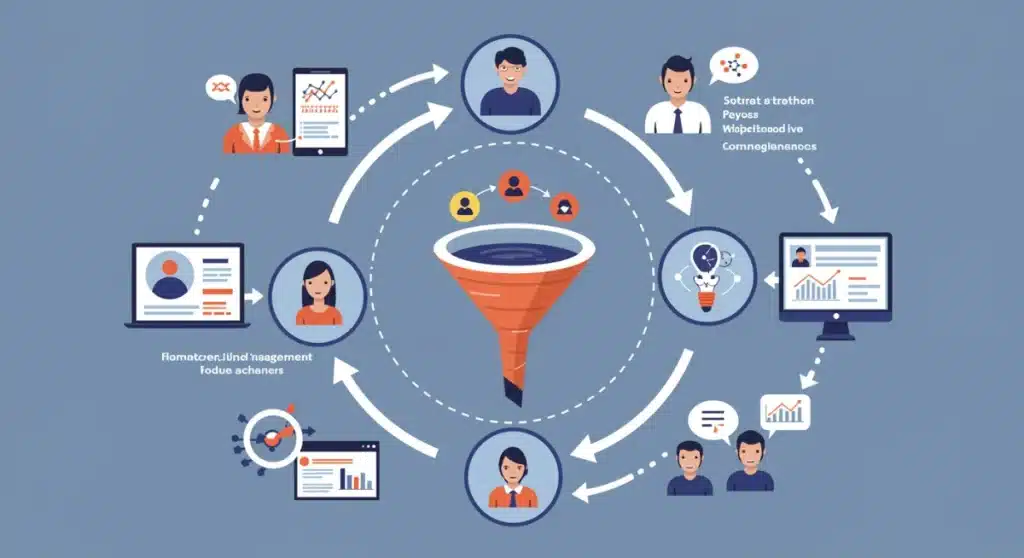Circular Marketing Strategy: Boost Customer Lifetime Value 25% by 2025

A circular marketing strategy prioritizes continuous customer engagement and feedback loops, leading to enhanced loyalty, reduced churn, and a projected 25% increase in customer lifetime value by 2025 for forward-thinking businesses.
The traditional marketing funnel, with its linear progression from awareness to purchase, has long been the bedrock of business strategy. However, in today’s dynamic, customer-centric landscape, this model often falls short, neglecting the crucial post-purchase relationship. This is where embracing a circular marketing strategy becomes not just an advantage, but a necessity, promising a significant boost in customer lifetime value (CLV) by 2025 and fostering sustainable growth that transcends mere transactions.
Understanding the limitations of the traditional funnel
For decades, marketers have relied on the sales funnel to visualize the customer journey, guiding prospects through stages like awareness, interest, desire, and action. While effective for initial acquisition, this linear approach often overlooks the immense value inherent in post-purchase engagement, leaving potential for long-term loyalty and advocacy untapped.
The traditional funnel implicitly suggests a finite journey, ending once a sale is made. This perspective fails to acknowledge the recurring revenue potential, referral opportunities, and invaluable feedback that satisfied customers can provide. In an era where customer retention costs significantly less than acquisition, ignoring the post-sale phase is a critical misstep.
The funnel’s inherent flaws in modern marketing
The digital age has empowered consumers, giving them unprecedented access to information and a louder voice. Their journey is rarely linear; it involves multiple touchpoints, research, and peer reviews. The funnel, by its very design, struggles to account for these complexities, often leading to a transactional rather than relational focus.
- Lack of post-purchase emphasis: The funnel’s conclusion at purchase neglects retention and advocacy.
- Ignores customer feedback: No clear mechanism for incorporating customer insights into product or service improvement.
- Linearity in a non-linear world: Fails to represent the actual, often circuitous, customer journey.
- Transactional mindset: Prioritizes single sales over long-term customer relationships.
By focusing solely on converting prospects, businesses risk alienating customers who feel valued only during the sales process. This oversight can lead to higher churn rates and missed opportunities for organic growth through word-of-mouth marketing, making a strong case for a more holistic approach.
Introducing the circular marketing strategy
Unlike the linear sales funnel, a circular marketing strategy views the customer journey as a continuous loop, emphasizing ongoing engagement, retention, and advocacy. This model acknowledges that a purchase is not an end, but a crucial touchpoint within an evolving relationship. It’s about creating a perpetual cycle of value for both the customer and the business.
The core principle is to keep customers engaged long after their initial purchase, transforming them into loyal advocates who not only return for more but also actively promote the brand. This continuous interaction builds stronger relationships, gathers valuable feedback, and ultimately drives sustainable growth and increased customer lifetime value.
Key components of the circular model
A successful circular strategy integrates several interconnected elements designed to nurture customer relationships at every stage. It moves beyond simply attracting and converting, focusing on creating a positive, enduring experience that encourages repeat business and enthusiastic referrals.
- Attraction: Drawing in potential customers with compelling content and value.
- Engagement: Building relationships through personalized interactions and valuable resources.
- Conversion: Guiding prospects to make a purchase, but with an eye on the future relationship.
- Retention: Keeping existing customers satisfied through excellent service, support, and ongoing value.
- Advocacy: Empowering loyal customers to become brand champions, sharing their positive experiences.
Each component feeds into the next, creating a self-sustaining ecosystem where customer satisfaction fuels growth. This holistic view ensures that every interaction contributes to strengthening the customer-brand bond, making the entire process more resilient and profitable.
The five interconnected stages of circular marketing
Implementing a circular marketing strategy requires a clear understanding of its distinct, yet interconnected, stages. These stages work in harmony to foster continuous customer engagement, transforming initial interest into lasting loyalty and advocacy.
Each stage is critical, building upon the last to create a seamless and valuable customer experience. By meticulously planning and executing activities within each phase, businesses can ensure a robust and effective circular model that consistently delivers value and drives repeat business.
Stage 1: Attraction – capturing initial interest
The attraction stage is about drawing in potential customers who align with your brand’s values and offerings. This involves creating compelling content and using targeted channels to reach the right audience, moving beyond generic messaging to cultivate genuine interest.
- Content marketing: Creating valuable blog posts, videos, and guides that address customer pain points.
- SEO and SEM: Optimizing for search engines to increase visibility and attract organic traffic.
- Social media engagement: Building a strong presence on platforms where your target audience spends time.
- Partnerships: Collaborating with complementary businesses to expand reach and credibility.
The goal is not just to generate leads, but to attract individuals who are genuinely interested in what your brand offers, setting the foundation for a meaningful relationship.
Stage 2: Engagement – nurturing relationships
Once attracted, customers need to be engaged through meaningful interactions that build trust and demonstrate value. This stage focuses on personalized communication and providing resources that help prospects make informed decisions, moving them closer to conversion.
- Email nurturing campaigns: Delivering relevant content and offers based on user behavior.
- Interactive content: Quizzes, polls, and webinars that encourage participation.
- Personalized website experiences: Tailoring content and recommendations to individual preferences.
- Customer service interactions: Providing excellent support and addressing inquiries promptly.
Effective engagement shows customers that you understand their needs and are committed to providing solutions, fostering a sense of connection and loyalty even before a purchase is made.
Stage 3: Conversion – facilitating the purchase
The conversion stage is where prospects become customers. While crucial, in a circular model, this is viewed as a milestone in an ongoing relationship, not the endpoint. The focus remains on a smooth, positive experience that encourages future interactions.
Optimizing the conversion process involves clear calls to action, simplified purchasing paths, and transparent communication about products or services. A seamless transaction sets a positive tone for the subsequent stages of retention and advocacy.
- Streamlined checkout processes: Minimizing friction and reducing abandonment rates.
- Clear value propositions: Articulating the benefits of your offering effectively.
- Trust signals: Displaying reviews, testimonials, and security badges.
- Personalized offers: Presenting relevant incentives to encourage purchase.
A positive conversion experience reinforces the customer’s decision and makes them more receptive to continued engagement with your brand.
Stage 4: Retention – building lasting loyalty
This is where the circular model truly distinguishes itself. Retention strategies aim to keep customers satisfied, engaged, and returning for more. It’s about demonstrating ongoing value and making customers feel appreciated, transforming a single purchase into a long-term relationship.
Effective retention involves proactive communication, exceptional support, and exclusive benefits that reward loyalty. By continuously adding value, businesses can significantly reduce churn and build a stable customer base.
- Post-purchase follow-ups: Checking in to ensure satisfaction and offer assistance.
- Loyalty programs and rewards: Incentivizing repeat purchases and engagement.
- Exclusive content and offers: Providing special access or discounts to loyal customers.
- Proactive customer support: Addressing potential issues before they escalate.
Investing in retention not only secures future revenue but also lays the groundwork for powerful advocacy, as satisfied customers are more likely to share their positive experiences.
Stage 5: Advocacy – empowering brand champions
The final stage, advocacy, sees satisfied customers become active promoters of your brand. They share their positive experiences, refer new customers, and provide invaluable feedback, closing the loop and attracting new prospects into the circular model.
Empowering advocacy involves making it easy for customers to share their stories and providing platforms for their voices to be heard. This organic growth is highly credible and often more effective than traditional advertising.
- Referral programs: Rewarding customers for bringing in new business.
- Review platforms: Encouraging and showcasing positive customer testimonials.
- User-generated content campaigns: Inviting customers to share their experiences.
- Community building: Creating spaces for customers to connect and share insights.
Advocacy not only drives new customer acquisition but also reinforces the brand’s reputation and credibility, making it a cornerstone of sustainable growth within the circular marketing framework.
Strategies for increasing customer lifetime value
Increasing customer lifetime value (CLV) is the ultimate goal of a circular marketing strategy. By focusing on retention and advocacy, businesses can significantly extend the revenue generated from each customer over their entire relationship with the brand. This requires a shift from short-term transactional thinking to long-term relational investment.
Strategies for boosting CLV are multifaceted, encompassing personalized experiences, exceptional service, and continuous value delivery. Each interaction should aim to deepen the customer’s connection to the brand, making them less likely to churn and more likely to spend more over time.
Personalization at scale
Tailoring experiences to individual customer preferences is no longer a luxury but a necessity. Leveraging data to understand customer behavior, purchase history, and preferences allows businesses to offer highly relevant products, services, and content, making each interaction feel unique and valuable.
- Segmented email campaigns: Sending targeted messages based on demographics and behavior.
- Personalized product recommendations: Suggesting items relevant to past purchases or browsing history.
- Customized content delivery: Providing information that directly addresses individual needs and interests.
- Dynamic website experiences: Adapting site content based on user profiles and past interactions.
Personalization fosters a sense of being understood and valued, significantly enhancing the customer experience and encouraging continued engagement.
Exceptional customer service and support
Outstanding customer service is a cornerstone of retention. When customers feel heard, supported, and valued, they are far more likely to remain loyal. This extends beyond resolving issues to proactive engagement and anticipating needs, creating a positive emotional connection with the brand.
Investing in well-trained support staff, implementing efficient communication channels, and empowering representatives to resolve problems quickly and effectively are crucial. A positive service experience can turn a potentially negative situation into an opportunity to strengthen loyalty.
- 24/7 support options: Offering assistance through various channels like chat, phone, and email.
- Knowledge base and FAQs: Empowering customers to find answers independently.
- Proactive problem-solving: Identifying and addressing issues before customers report them.
- Follow-up after service interactions: Ensuring satisfaction and offering further assistance.
Superior customer service transforms transactions into relationships, making customers feel cared for and appreciated, which is vital for long-term CLV.
Measuring success and optimizing the circular model
To ensure a circular marketing strategy is effective, it’s crucial to establish clear metrics and continuously monitor performance. This allows businesses to identify areas for improvement, optimize their efforts, and demonstrate the tangible impact on customer lifetime value and overall business growth.
Regular analysis and adaptation are key to maintaining the dynamism of the circular model. By understanding what works and what doesn’t, marketers can refine their strategies to maximize efficiency and profitability.
Key performance indicators for circular marketing
Tracking specific KPIs provides actionable insights into the health and effectiveness of your circular marketing efforts. These metrics go beyond traditional sales figures to encompass customer engagement, satisfaction, and loyalty.
- Customer Lifetime Value (CLV): The projected revenue a customer will generate over their relationship with a brand.
- Customer Retention Rate: The percentage of customers a business retains over a given period.
- Churn Rate: The percentage of customers who stop doing business with a company.
- Net Promoter Score (NPS): Measures customer loyalty and willingness to recommend a product or service.
- Repeat Purchase Rate: The percentage of customers who make more than one purchase.
By focusing on these metrics, businesses can gain a comprehensive understanding of their customers’ journey and the impact of their circular marketing initiatives.
Tools and technologies for optimization
Leveraging the right tools and technologies is essential for effectively implementing, tracking, and optimizing a circular marketing strategy. These platforms can automate processes, provide deep insights, and enhance personalization efforts at scale.
From CRM systems to marketing automation platforms, technology empowers businesses to manage complex customer interactions, analyze data, and deliver targeted experiences throughout the customer lifecycle.
- CRM (Customer Relationship Management) software: To manage customer interactions and data.
- Marketing automation platforms: For automating email campaigns, personalized content delivery, and more.
- Analytics tools: To track website traffic, customer behavior, and campaign performance.
- Customer feedback platforms: For gathering and analyzing reviews, surveys, and testimonials.
These tools enable a data-driven approach to circular marketing, ensuring that decisions are informed and strategies are continuously refined for maximum impact.
The future of marketing: sustainability and relationship building
As consumer expectations evolve and the competitive landscape intensifies, the future of marketing increasingly hinges on sustainability and the cultivation of genuine, long-term relationships. A circular marketing strategy is perfectly poised to meet these demands, offering a framework for enduring success.
This paradigm shift moves beyond fleeting campaigns and transactional exchanges to embrace a philosophy of continuous value creation and mutual growth. Businesses that prioritize relationships over mere transactions will be the ones that thrive in the coming years.
Building a sustainable brand through circularity
A circular approach inherently fosters sustainability, not just in terms of environmental impact, but in business longevity. By reducing customer churn and encouraging advocacy, brands build a resilient customer base that drives consistent revenue and organic growth, lessening reliance on constant new customer acquisition.
This focus on existing customers also leads to more efficient resource allocation, as the cost of retaining a customer is typically much lower than acquiring a new one. The result is a more stable, profitable, and ethically sound business model.
- Reduced acquisition costs: Lower reliance on expensive new customer outreach.
- Increased brand loyalty: A dedicated customer base that withstands market fluctuations.
- Enhanced brand reputation: Positive word-of-mouth and genuine advocacy.
- Valuable customer insights: Continuous feedback for product and service improvement.
Embracing circularity positions a brand as forward-thinking and customer-centric, appealing to modern consumers who value authenticity and long-term commitment.
Beyond transactions: the power of community and trust
In a circular marketing model, the relationship extends far beyond the point of sale. It’s about building a community around your brand, where customers feel connected, valued, and part of something larger. This fosters deep trust, which is invaluable in today’s often skeptical marketplace.
By creating platforms for interaction, celebrating customer successes, and actively listening to feedback, businesses can transform customers into true partners. This level of trust and community engagement creates a formidable competitive advantage, driving both loyalty and advocacy.
- Online forums and groups: Facilitating customer interaction and support.
- User-generated content showcases: Highlighting customer creativity and experiences.
- Customer advisory boards: Involving customers in product development and strategy.
- Transparent communication: Building trust through honesty and openness.
The power of a loyal community, built on trust and shared values, is a cornerstone of the circular marketing strategy, ensuring sustained growth and a positive brand image.
| Key Aspect | Description |
|---|---|
| Beyond the Funnel | Shifts from linear sales process to continuous customer relationships. |
| Core Principle | Continuous engagement, retention, and advocacy for sustainable growth. |
| CLV Increase Goal | Aims for 25% higher Customer Lifetime Value by 2025. |
| Key Stages | Attraction, Engagement, Conversion, Retention, and Advocacy. |
Frequently asked questions about circular marketing
The primary difference lies in their approach to the customer journey. Traditional marketing is linear, ending at purchase, while circular marketing views the journey as a continuous loop, focusing on post-purchase engagement, retention, and advocacy to foster long-term customer relationships and sustainable growth.
Circular marketing significantly boosts CLV by prioritizing retention and advocacy. By keeping customers engaged and satisfied long after the initial purchase, it encourages repeat business, reduces churn, and transforms customers into brand advocates, thereby increasing the total revenue generated per customer.
The five key stages are Attraction, Engagement, Conversion, Retention, and Advocacy. These stages form a continuous loop, where advocacy feeds back into attraction, creating a self-sustaining cycle of customer acquisition and loyalty. Each stage builds upon the previous one.
Personalization is crucial because it makes customers feel valued and understood. By tailoring content, offers, and interactions based on individual preferences and behavior, businesses can deepen customer relationships, enhance satisfaction, and significantly improve retention rates within the circular model.
Technology is vital for effective implementation, tracking, and optimization. CRM systems, marketing automation platforms, and analytics tools enable businesses to manage customer data, automate personalized communications, measure performance, and gain insights to refine their circular marketing efforts at scale.
Conclusion
The shift from a linear marketing funnel to a dynamic, circular marketing strategy represents a fundamental evolution in how businesses approach customer relationships and growth. By prioritizing continuous engagement, retention, and advocacy, companies can unlock substantial increases in customer lifetime value, moving beyond mere transactions to build lasting loyalty and a robust community of brand champions. Embracing this holistic, customer-centric approach is not just a trend but a strategic imperative for sustainable success in 2025 and beyond.





